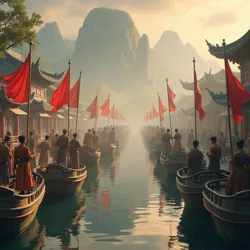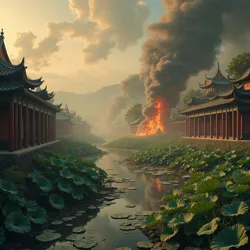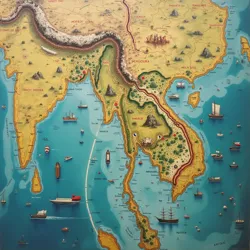Western Incursion in the Jade Lands

Western powers exert influence over the Jade Lands in the 19th and 20th centuries, marking a shift from isolation to global integration.
Western Incursion
西風漸侵 (Xīfēng Jiànqīn)
Era of External Pressures
19th
early 20th
unequal treaties
Opium Equivalency Wars
Jade Lands
Western Incursion (西風漸侵, Xīfēng Jiànqīn), sometimes referred to as the Era of External Pressures (外壓時代, Wài Yā Shídài), denotes the period in the 19th and early 20th centuries during which states from the western continent, known within the Jade Lands as the 'Western Powers' (西方列強, Xīfāng Lièqiáng), exerted significant military, economic, and cultural influence over the region. This era marked a profound shift in the historical trajectory of the Jade Lands, moving it from a relatively isolated and internally focused collection of states to one increasingly integrated, though often involuntarily, into a global system dominated by distant powers. The Western Incursion period is characterized by a series of unequal treaties, military interventions, the establishment of foreign concessions, and a widespread, if uneven, process of modernization and societal transformation within the Jade Lands states.
Historical Context: The Jade Lands Before the Incursion
Prior to the 19th century, the Jade Lands maintained a complex but largely self-contained geopolitical and economic system. For centuries, the region had been characterized by a dynamic interplay between multiple independent states, each vying for power and influence, yet also bound by a shared cultural and spiritual heritage rooted in the Concordian Way. This 'Age of Contending States' (爭國時代, Zhēng Guó Shídài), lasting from the 14th to the 18th centuries, fostered a unique balance of competition and cooperation, allowing for significant advancements in art, commerce, and philosophy, even amidst persistent inter-state rivalries.
 Independent Jade Lands states like Liang-Ning, Yong-An, Jing-Hua, and Shu-Han compete and cooperate within a shared cultural heritage.
Independent Jade Lands states like Liang-Ning, Yong-An, Jing-Hua, and Shu-Han compete and cooperate within a shared cultural heritage.The states of Liang-Ning, Yong-An, Jing-Hua, and Shu-Han, among others, had developed distinct identities and spheres of influence. Liang-Ning (梁寧, Liángníng), in the north, was known for its military strength and pragmatic governance, often dealing with nomadic groups from the steppes. Yong-An (永安, Yǒng'ān), situated in the central plains, cultivated an image as the cultural and political successor to the Tang Dynasty (唐朝, Táng Cháo), emphasizing Confucian ideals and artistic patronage. Jing-Hua (京華, Jīnghuá), with its eastern coastal location, thrived as a maritime trading power, connecting the Jade Lands to markets across the southern seas and beyond. Shu-Han (蜀漢, Shǔhàn), nestled in the Sichuan basin, maintained a degree of relative isolation, fostering a unique and rich regional culture.
While the Jade Lands engaged in trade and diplomatic exchanges with neighboring regions, including the Islamic polities to the west, these interactions were generally conducted on terms of relative parity. The Silk Roads facilitated overland commerce, and maritime routes connected the coastal states with Southeast Asia, India, and even the easternmost reaches of Africa. However, these exchanges did not fundamentally challenge the internal political and economic structures of the Jade Lands states. The region, while aware of the world beyond, largely perceived itself as the center of its own world, a perspective reinforced by the philosophical tenets of the Concordian Way, which emphasized harmonious self-sufficiency and inward cultivation.
This relative isolation and inward focus began to shift dramatically in the 19th century with the increasing assertiveness of Western Powers. These nations, propelled by the Industrial Revolution and driven by mercantilist and imperial ambitions, sought new markets, resources, and spheres of influence across the globe. The Jade Lands, with its vast population, rich resources, and fragmented political landscape, became a prime target for Western expansion.
Early Encounters and Growing Western Interest
Initial contacts between the Jade Lands and Western emissaries were tentative and often misunderstood by both sides. In the late 18th and early 19th centuries, exploratory voyages and trade missions from Western nations, primarily from the Kingdom of Albion (a fictional analogue to Great Britain) and the Republic of Gallia (a fictional analogue to France), began to probe the coastal regions of the Jade Lands, particularly targeting Jing-Hua and Minyue (閩越, Mǐnyuè). These early interactions were largely driven by trade interests, specifically the desire to acquire Jade Lands goods such as silk, porcelain, tea, and spices, which were highly sought after in Western markets.
However, the Western approach to trade differed significantly from the established practices within the Jade Lands and with their traditional trading partners. Western merchants and governments sought not just trade, but also greater access to Jade Lands markets, the establishment of permanent trading posts, and the enforcement of trade terms favorable to themselves. This clashed with the prevailing tributary system and regulated trade practices of the Jade Lands states, which often restricted foreign access and imposed strict controls on commerce.
Early Western diplomatic missions to the Jade Lands courts were often met with a mixture of curiosity and suspicion. Jade Lands rulers, accustomed to dealing with other states within their cultural sphere, struggled to understand the motivations and demands of these distant newcomers. Western envoys, in turn, often misinterpreted Jade Lands courtly protocols and perceived the cautious responses as arrogance or intransigence. These misunderstandings were compounded by cultural and linguistic barriers, as well as fundamentally different worldviews.
One early example of this friction was the Albionian Macartney Mission analogue (though in this alternate history, it might be called the "Eastwood Expedition" after a fictional explorer). Albion, seeking to expand its trading opportunities, dispatched a large embassy to the court of Yong-An, seeking to negotiate a comprehensive trade agreement. The Albionians sought the opening of more ports, the establishment of a permanent embassy, and the reduction of tariffs. However, the Yong-An court, under the influence of conservative officials wary of foreign encroachment and adhering to the principles of regulated trade, ultimately rejected most of the Albionian demands. This initial rebuff set the stage for future conflicts and misunderstandings.
The Opium Equivalency Wars and Treaty Ports
The turning point in the Western Incursion was the series of military conflicts often termed the 'Opium Equivalency Wars' (鴉片對等戰爭, Yāpiàn Duìděng Zhànzhēng). These wars, analogous to the Opium Wars in our world's history, were sparked by the Western Powers' aggressive promotion of the trade of 'Black Lotus' (黑蓮, Hēi Lián), a fictional but equally debilitating narcotic substance, into the Jade Lands. Despite official prohibitions and moral objections from Jade Lands authorities, Western merchants, particularly those from Albion, continued to smuggle Black Lotus into the region, seeking to create a lucrative market and redress trade imbalances.
 Western powers initiate wars through Black Lotus trade, causing addiction, social disorder, and military conflict in the Jade Lands.
Western powers initiate wars through Black Lotus trade, causing addiction, social disorder, and military conflict in the Jade Lands.The consequences of the Black Lotus trade were devastating. Addiction spread rapidly, undermining social order, weakening the economy, and creating a major public health crisis within Jade Lands states. When Jing-Hua authorities attempted to enforce their prohibition and confiscated large quantities of Black Lotus from Western merchants, Albion, using this as a pretext, launched a military expedition.
The First Opium Equivalency War (第一次鴉片對等戰爭, Dì Yī Cì Yāpiàn Duìděng Zhànzhēng) (1839-1842, in analogy to our world's First Opium War) exposed the stark military disparity between the Jade Lands states and the Western Powers. Albionian naval and military technology, far more advanced than anything possessed by the Jade Lands, proved decisive. Jing-Hua, despite valiant resistance, suffered a series of defeats. The war concluded with the Treaty of Pearl River (珠江條約, Zhū Jiāng Tiáoyuē), an unequal treaty that forced Jing-Hua to make significant concessions.
The Treaty of Pearl River, and subsequent treaties imposed on other Jade Lands states, became the template for Western domination. Key provisions typically included:
- Opening of Treaty Ports: Jade Lands states were compelled to open specific ports to foreign trade and residence. These treaty ports, such as Jinghua, Yongan, and Liangning City, became enclaves of Western influence, operating largely outside of Jade Lands legal jurisdiction.
- Extraterritoriality: Western citizens residing in the treaty ports were granted extraterritoriality, meaning they were subject to the laws of their own nations, not those of the Jade Lands states. This severely undermined Jade Lands sovereignty and created legal inequalities.
- Fixed Tariffs: Jade Lands states were forced to agree to low, fixed tariffs on imported goods, preventing them from protecting their domestic industries. This opened Jade Lands markets to a flood of cheaper Western manufactured goods.
- Most-Favored-Nation Status: Any concession granted to one Western power had to be automatically extended to all others, ensuring that Western nations acted in concert to maximize their advantages.
- Indemnities: Jade Lands states were forced to pay large indemnities to Western powers as compensation for the costs of the war and alleged damages. These indemnities further strained Jade Lands economies.
- Cession of Territory: In some cases, Jade Lands states were forced to cede territory to Western powers. For example, Albion acquired the island of Hong Kong analogue (perhaps called "Jade Isle" 玉島, Yù Dǎo) from Jing-Hua under the Treaty of Pearl River.
The Second Opium Equivalency War (第二次鴉片對等戰爭, Dì Èr Cì Yāpiàn Duìděng Zhànzhēng) (1856-1860, analogous to our world's Second Opium War), involved a coalition of Western Powers, including Albion and Gallia, further expanded Western privileges and deepened the humiliation of the Jade Lands. This war was triggered by further disputes over trade and Western demands for greater access and control. The sack of the Yong-An Summer Palace analogue (perhaps "Garden of Perpetual Harmony" 永恆和諧園林, Yǒnghéng Héxié Yuánlín) by Western forces became a symbol of the Jade Lands' vulnerability and the brutality of Western encroachment.
Impact of Western Incursion on Jade Lands States
The Western Incursion had a multifaceted and profound impact on the Jade Lands, affecting political, economic, social, and cultural spheres.
 Treaty ports become enclaves of Western influence with extraterritoriality and fixed tariffs, undermining Jade Lands sovereignty.
Treaty ports become enclaves of Western influence with extraterritoriality and fixed tariffs, undermining Jade Lands sovereignty.Political Disruption and Erosion of Sovereignty
Politically, the Western Incursion fundamentally undermined the sovereignty and autonomy of the Jade Lands states. The imposition of unequal treaties stripped them of control over their tariffs, legal systems, and even parts of their territory. The treaty port system created states-within-states, where Western powers exercised de facto control, further fragmenting Jade Lands authority.
The Qing Dynasty analogue in our world was significantly weakened by Western incursions, leading to internal rebellions and eventual collapse. Similarly, in the Jade Lands, the established political order was destabilized. The Yong-An court, traditionally seen as the most prestigious and culturally influential, suffered a significant loss of face and legitimacy. Other states, like Liang-Ning and Jing-Hua, also faced internal pressures and challenges to their authority as a result of their inability to effectively resist Western demands.
The Western Powers also actively interfered in Jade Lands internal affairs, often playing states against each other to further their own interests. They provided support to certain factions or rulers, exacerbating existing inter-state rivalries and hindering any potential for unified resistance. The concept of 'sphere of influence' became prevalent, with different Western powers carving out regions of the Jade Lands for their exclusive economic and political domination.
Economic Transformation and Exploitation
Economically, the Western Incursion triggered a significant transformation, often characterized by exploitation and unequal exchange. The influx of Western manufactured goods, facilitated by low tariffs, undermined local industries and handicrafts. Jade Lands economies became increasingly integrated into the global capitalist system, but primarily as suppliers of raw materials and consumers of Western products, rather than as equal participants.
The treaty ports became centers of foreign trade and economic activity, but the benefits largely accrued to Western merchants and companies. Jade Lands traders and businesses were often marginalized, facing unfair competition and discriminatory practices. The extraction of resources, such as minerals and agricultural products, intensified, often under exploitative conditions.
However, the Western Incursion also introduced new economic concepts and technologies to the Jade Lands. The treaty ports facilitated the introduction of Western banking, shipping, and industrial practices. Some forward-thinking Jade Lands elites recognized the need to modernize their economies to compete with the West, leading to nascent industrialization efforts in some regions.
Social and Cultural Upheaval
Socially and culturally, the Western Incursion brought significant upheaval and transformation. The rapid spread of Black Lotus addiction was just one manifestation of the social disruption. The influx of Western ideas, religions, and cultural practices challenged traditional norms and values.
Western missionaries, often operating under the protection of unequal treaties, actively proselytized Christianity and other Western faiths. While they achieved some conversions, their activities often generated resentment and social tensions, particularly among adherents of the Concordian Way and other indigenous belief systems. Western education and cultural institutions were also introduced, offering new opportunities but also contributing to cultural displacement and the erosion of traditional learning.
The treaty ports became centers of cultural exchange and hybridity, but also of social segregation and inequality. Western enclaves often operated according to their own social norms and racial hierarchies, reinforcing feelings of humiliation and resentment among the Jade Lands populace.
Responses and Reforms: Modernization and Resistance
Faced with the challenges of Western Incursion, the Jade Lands states adopted a range of responses, from outright resistance to attempts at modernization and reform. These responses were often complex, contradictory, and varied across different states and regions.
Resistance Movements
Popular resistance to Western Incursion took various forms, ranging from localized uprisings to organized rebellions. These movements were often fueled by a combination of anti-foreign sentiment, economic grievances, and religious fervor. Secret societies, often with roots in folk religious traditions, played a significant role in organizing resistance.
The 'Righteous Harmony Society Uprising' analogue (perhaps the 'Uprising of Concordian Purity' 協和純潔起義, Xiéhé Chúnjié Qǐyì) was a major anti-Western rebellion that erupted in the late 19th century, fueled by resentment against foreign encroachment and Christian missionary activities. While ultimately suppressed by a coalition of Jade Lands and Western forces, it demonstrated the depth of popular anger and resistance to Western domination.
Self-Strengthening and Modernization
Recognizing the military and technological superiority of the Western Powers, some Jade Lands elites advocated for 'Self-Strengthening' (自強, Zìqiáng) and modernization. This movement aimed to adopt Western technologies, military systems, and industrial practices while preserving the core of Jade Lands culture and values.
States like Liang-Ning and Jing-Hua were at the forefront of these modernization efforts. They invested in building modern armies and navies, establishing arsenals and shipyards, and promoting industrial development. They sent students abroad to study Western science and technology and invited Western advisors to assist in their modernization programs.
However, these modernization efforts were often hampered by internal resistance from conservative factions, limited resources, and the ongoing pressures of Western encroachment. The self-strengthening movement achieved some successes, but it was ultimately insufficient to fully reverse the tide of Western influence or to achieve true parity with the Western Powers.
Reform Movements and Constitutionalism
In the late 19th and early 20th centuries, reform movements emerged within some Jade Lands states, advocating for more fundamental political and social changes. Inspired by Western political thought and the examples of constitutional monarchies and republics, reformers sought to transform the autocratic political systems of the Jade Lands into more modern and representative forms of government.
The 'Hundred Days Reform' analogue (perhaps 'The Yong-An Spring Reforms' 永安春季改革, Yǒng'ān Chūnjì Gǎigé) in Yong-An was a notable attempt at top-down reform, initiated by reform-minded officials at the court. It aimed to modernize the education system, streamline the bureaucracy, and promote industrial and commercial development. However, the reforms were short-lived, facing strong opposition from conservative elements and a coup led by powerful conservative figures brought the reform movement to an abrupt end.
Despite the setbacks, the ideas of reform and constitutionalism continued to circulate within the Jade Lands, particularly among intellectuals and urban populations. These ideas would play a significant role in the political transformations of the 20th century.
The Legacy of Western Incursion
The Western Incursion period left a lasting legacy on the Jade Lands, shaping its political landscape, economic development, and cultural identity in profound ways. While the era of formal Western domination eventually came to an end, its impacts continue to resonate in the modern Jade Lands.
Enduring Political Fragmentation and National Aspirations
The Western Incursion exacerbated existing political divisions within the Jade Lands and hindered the emergence of a unified national state. The treaty port system and spheres of influence further fragmented the region, reinforcing the independence of the various states.
However, the experience of Western Incursion also fostered a sense of shared victimhood and a nascent sense of pan-Jade Lands nationalism. The desire to resist foreign domination and to restore national strength became a powerful unifying force. In the 20th century, movements for national unification and independence gained momentum, drawing inspiration from both indigenous traditions and Western nationalist ideologies. The legacy of the Western Incursion thus contributed to the complex interplay between regionalism and nationalism that continues to characterize the Jade Lands.
Uneven Economic Development and Modernization Trajectories
The economic impact of the Western Incursion was uneven, creating disparities between treaty port regions and the interior, and between states that embraced modernization more actively and those that remained more resistant to change. The treaty ports and coastal regions experienced more rapid economic development, often driven by foreign investment and trade, while the interior regions remained relatively underdeveloped.
The legacy of this uneven development persists in the modern Jade Lands, with some states and regions being significantly more prosperous and industrialized than others. The challenges of bridging these economic divides and achieving more balanced development remain significant.
Cultural Hybridity and the Search for Identity
Culturally, the Western Incursion resulted in a complex process of hybridity and cultural exchange. Western ideas, technologies, and cultural practices were adopted and adapted within the Jade Lands, leading to new forms of art, literature, and social expression. However, this process was also accompanied by cultural tensions and anxieties, as traditional values and identities were challenged by Western influences.
The legacy of this cultural encounter is evident in the modern Jade Lands, which exhibits a vibrant mix of traditional and modern, indigenous and foreign cultural elements. The search for a distinct Jade Lands identity in a globalized world, one that acknowledges both its rich heritage and its engagement with the West, remains an ongoing process.
In conclusion, the Western Incursion was a transformative period in the history of the Jade Lands, marking a forceful and often traumatic encounter with the expanding Western world. It left an indelible mark on the region's political, economic, social, and cultural landscape, shaping its trajectory into the modern era. The legacy of this era continues to inform the challenges and opportunities facing the Jade Lands states as they navigate the complexities of the 21st century.